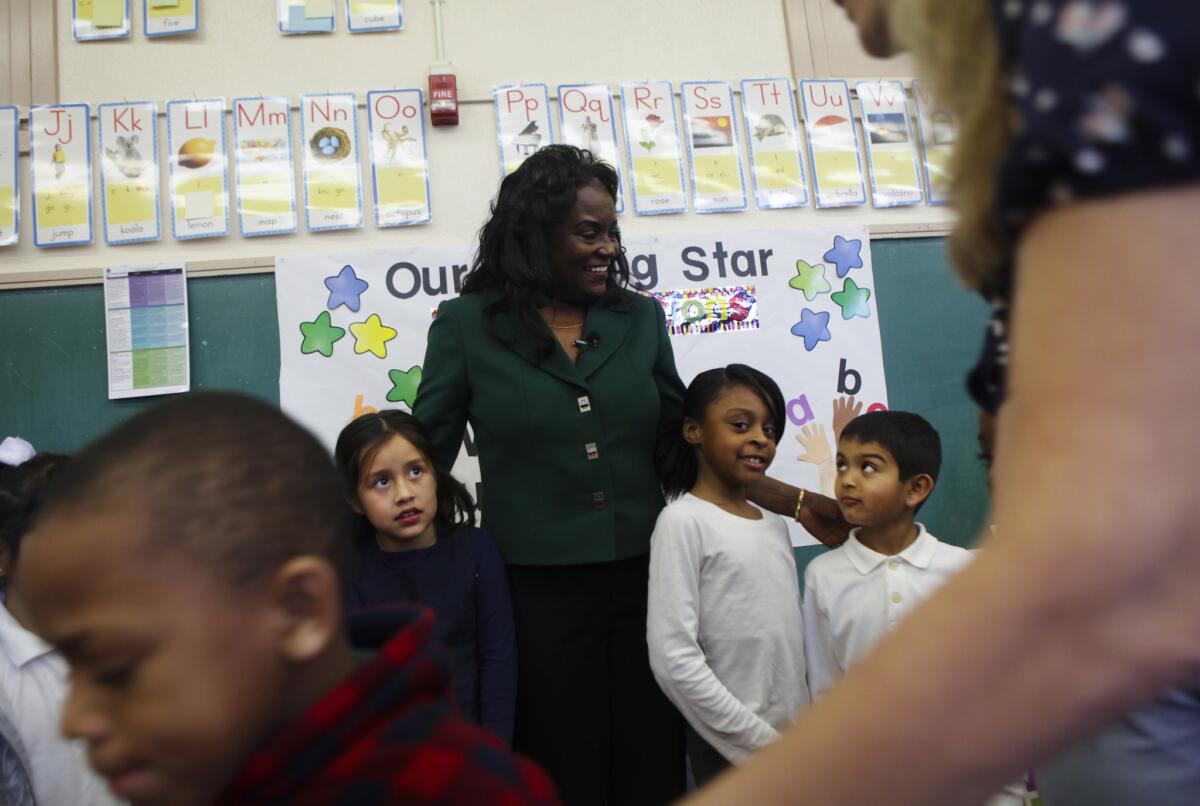The new head of L.A.’s schools knows what it feels like to experience inequality in education

Newly appointed L.A. Unified Supt. Michelle King stops by Century Park Elementary School during a two-day tour of the schools she attended as a child.
In the 1970s, Michelle King took advanced classes at Palisades High School. But she didn’t see many students who looked like her.
“Sometimes I was one of few African American students in a particular higher-level class,” the new L.A. Unified superintendent said in an interview Tuesday during a visit to Century Park Elementary School, where she attended kindergarten.
The problem she described has been well-documented, and it’s referred to as tracking. Students of color, especially black and Latino students, are kept out of higher-level classes because of entrance requirements such as grades, admission tests, teacher recommendations and other factors that are out of their control.
See more of our top stories on Facebook >>
And it’s an experience that students at King’s alma mater — now Palisades Charter High School — still experience.
Two Palisades Charter High students— Jhyre Alvarado and Arianna McMillon — were on a panel of L.A. Unified students of color in August. As we reported this fall:
[B]oth said that in their school, which is about 24% Latino and 14% black, they are sometimes the only person in their high-level classes representing their ethnic groups.
...
“If you look around, it’s true. If you see all the other AP classes, it’s true,” Alvarado said. “The only one that’s really meant for us is probably AP Spanish.”
There is a smaller percentage of black and Latino students in AP classes compared with the student population of Palisades Charter High, Assistant Principal Kimberly Theard said.
The school is trying to address this by adding classes and sections and by encouraging students to enroll in AP classes. However, the school focuses more on increasing the number of underrepresented students completing classes known as A-G requirements so they can be eligible for UC and CSU enrollment, Theard said.
It’s not just a problem at Palisades Charter High. In the 2009-10 school year, L.A. Unified began allowing any student to enroll in AP classes. Since then, AP classes have started to more closely resemble the district as a whole.
That’s mostly because of an increase in Latino students, though, who have gone from 60% of AP enrollment to 68% since 2007. Black students have consistently represented 7% of AP enrollment, though they made up 10% of the district in the 2014-15 school year.

L.A. Unified Supt. Michelle King visits Century Park Elementary School. With her are students Darrell Bainton, front left, Valery Lopez, Anyah Robinson and Erik Rodriguez.
Advanced Placement and honors classes prepare students for college-level coursework and give them an edge in the college admissions process. Sometimes being tracked into a lower-level class means a student will not complete the course requirements to qualify for Cal State University or University of California enrollment.
Educators are still trying to fix this problem at every level. The U.S. Department of Education regularly investigates school districts for their tracking practices — the Office for Civil Rights investigated L.A. Unified in 2010 and required the district to come up with a plan to increase representation of black and Latino students in the district’s gifted and talented programs. A new California law requires school districts to develop placement policies for math classes. Some L.A. schools even require all students to take an AP class.
“I did see many of my friends that didn’t have that same opportunity that I had,” King said. “So that’s why it’s such a strong part of my passion in terms of what I want to see and be able to do for our district.”
Reach Sonali Kohli on Twitter @Sonali_Kohli or by email at [email protected].
MORE ON LAUSD’S NEW SUPERINTENDENT:
The country’s second-biggest school district has a new superintendent. But what does she even do?
Angelenos welcome their new schools superintendent -- with some reservations
Editorial: What new L.A. schools chief Michelle King needs to do now
More to Read
Sign up for Essential California
The most important California stories and recommendations in your inbox every morning.
You may occasionally receive promotional content from the Los Angeles Times.











